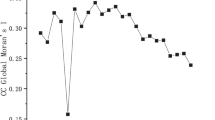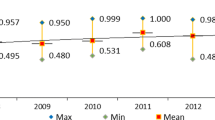Abstract
This study examines causal relationship between urbanization and coal consumption. By taking Shanxi Province, China, as a typical case area, a multivariate path analysis model is used to seek for the key driving factors of coal consumption throughout its urbanization during the period of 1978 to 2014. The result indicates that the key factors are urban household disposable income and residential area per capita, which are closely related to urban construction and household lifestyle. It is expected that the study may inform better policies on coal consumption reduction and energy structure improvement.


Similar content being viewed by others
References
Ai J, Feng L, Dong X, Zhu X, Li Y (2016) Exploring coupling coordination between urbanization and ecosystem quality (1985–2010): a case study from Lianyungang City, China. Front Earth Sci 10(3):527–545
Balat M (2009) Coal in the global energy scene. Energ Source Part B 5(1):50–62
Chen M, Yang X (2015) Situations and challenges of household energy consumption in Chinese small towns. Energ Build 107:155–162
Chen ZM, Liu Y, Qin P, Zhang B, Lester L, Chen G, Guo Y, Zheng X (2015) Environmental externality of coal use in China: welfare effect and tax regulation. Appl Energ 156:16–31
Dyson T (2011) The role of the demographic transition in the process of urbanization. Popul Dev Rev 37(s1):34–54
Friston KJ, Harrison L, Penny W (2003) Dynamic causal modelling. NeuroImage 19(4):1273–1302
Guo R, Gui H, Guo LC (2015) Multiregional economic development in China. Springer, Berlin
Guo S, Hu H, Liu L, Yin X (2016) Government expenditures and equity of opportunity in China. Public Financ Manag 16(1):9–24
Hair JF, Sarstedt M, Pieper TM, Ringle CM (2012) The use of partial least squares structural equation modeling in strategic management research: a review of past practices and recommendations for future applications. Long Range Plan 45:320–340
Hao Y, Liu YM (2016) The influential factors of urban PM 2.5 concentrations in China: a spatial econometric analysis. J Clean Prod 112:1443–1453
Hao Y, Zhang ZY, Liao H, Wei YM (2015) China’s farewell to coal: a forecast of coal consumption through 2020. Energ Policy 86:444–455
Henderson JV (2010) Cities and development. J Reg Sci 50(1):515–540
Huang X, Dijst M, van Weesep J, Zou N (2014) Residential mobility in China: home ownership among rural–urban migrants after reform of the hukou registration system. J Housing Built Environ 29(4):615–636
Ji X, Chen B (2015) Assessing the energy-saving effect of urbanization in China based on stochastic impacts by regression on population, affluence and technology (STIRPAT) model. J Clean Prod 24(2):206–209
Karagoz S, Bakirci K (2009) Sustainable energy development in Turkey. Energ Source Part B 5:63–73
Kaygusuz K (2012) Energy for sustainable development: a case of developing countries. Renew Sust Energ Rev 16:1116–1126
Li H, Dong L, Ren J (2015) Industrial symbiosis as a countermeasure for resource dependent city: a case study of Guiyang, China. J Clean Prod 107:252–266
Li Y, Beeton RJS, Sigler T, Halog A (2016) Modelling the transition toward urban sustainability: a case study of the industrial city of Jinchang, China. J Clean Prod 134:22–30
Lin W, Chen B, Luo S, Liang L (2014) Factor analysis of residential energy consumption at the provincial level in China. Sustainability 6:7710–7724
Liu Y, Xie Y (2013) Asymmetric adjustment of the dynamic relationship between energy intensity and urbanization in China. Energ Econ 36:43–54
Liu Y, Song Y, Arp HP (2012) Examination of the relationship between urban form and urban eco-efficiency in China. Habitat Int 36:171–177
Lucas RE Jr (2004) Life earnings and rural-urban migration. J Polit Econ 112(S1):S29–S59
McGuirk P, Argent N (2011) Population growth and change: implications for Australia’s cities and regions. Geogr Res 49(3):317–335
Mestl HES, Aunan K, Fang J, Seip HM, Skjelvik JM, Vennemo H (2005) Cleaner production as climate investment—integrated assessment in Taiyuan City, China. J Clean Prod 13(1):57–70
Muthén B, Asparouhov T (2015) Causal effects in mediation modeling: an introduction with applications to latent variables. Struct Equat Model 22:12–23
Pan L, Liu P, Ma L, Li Z (2012) A supply chain based assessment of water issues in the coal industry in China. Energ Policy 48:93–102
Qin B, Zhang Y (2014) Note on urbanization in China: urban definitions and census data. China Econ Rev 30:495–502
Ren L, Wang W, Wang J, Liu R (2015) Analysis of energy consumption and carbon emission during the urbanization of Shandong Province, China. J Clean Prod 103:534–541
Rezvani MR, Mansourian H, Sattari MH (2013) Evaluating quality of life in urban areas (case study: Noorabad City, Iran). Soc Indic Res 112:203–220
Seto KC, Sánchez-Rodríguez R, Fragkias M (2010) The new geography of contemporary urbanization and the environment. Ann Rev Environ Resour 35:167–194
Shan L, Ann TW, Wu Y (2017) Strategies for risk management in urban–rural conflict: two case studies of land acquisition in urbanising China. Habit Int 59:90–100
Shen L, Cheng S, Gunson AJ, Wan H (2005) Urbanization, sustainability and the utilization of energy and mineral resources in China. Cities 22(4):287–302
Sun C, Ouyang X, Cai H, Luo Z, Li A (2014) Household pathway selection of energy consumption during urbanization process in China. Energ Convers Manag 84:295–304
Wang Q (2014) Effects of urbanisation on energy consumption in China. Energ Policy 65:332–339
Wang G, Chen X, Zhang Z, Niu C (2015) Influencing factors of energy-related CO2 emissions in China: a decomposition analysis. Sustainability 7:14408–14426
Wang Q, Wu SD, Zeng YE, Wu BW (2016) Exploring the relationship between urbanization, energy consumption, and CO2 emissions in different provinces of China. Renew Sust Energ Rev 54:1563–1579
Wright S (1934) The method of path coefficients. Ann Math Stat 3:161–215
Xia Q, Qiu Y, Zhou M (2016) Economic regulations of coal enterprises’ scale expansion in China. Resour Conserv Recycl. https://doi.org/10.1016/j.resconrec.2016.09.003
Xing X, Liu Y, Yu M, Ma X (2016) Determination of dominant weather parameters on reference evapotranspiration by path analysis theory. Comput Electron Agri 120:10–16
Xu X, Xu X, Chen Q, Che H (2015) The impact on regional “resource curse” by coal resource tax reform in China—a dynamic CGE appraisal. Resour Policy 45:277–289
Xue B, Geng Y, Müller K, Lu C, Ren W (2014) Understanding the causality between carbon dioxide emission, fossil energy consumption and economic growth in developed countries: an empirical study. Sustainability 6(2):1037–1045
Yang G, Li W, Wang J, Zhang D (2016) A comparative study on the influential factors of China’s provincial energy intensity. Energ Policy 88:74–85
Yu S, Zhu K (2012) A hybrid procedure for energy demand forecasting in China. Energy 37:396–404
Yu S, Zhu K, Zhang X (2012) Energy demand projection of China using a path-coefficient analysis and PSO-GA approach. Energ Convers Manage 53:142–153
Yuan B, Ren S, Chen X (2015) The effects of urbanization, consumption ratio and consumption structure on residential indirect CO2 emissions in China: a regional comparative analysis. Appl Energ 140:94–106
Zhang J, Fu M, Geng Y, Tao J (2011a) Energy saving and emission reduction: a project of coal-resource integration in Shanxi Province, China. Energ Policy 39(6):3029–3032
Zhang N, Lior N, Jin H (2011b) The energy situation and its sustainable development strategy in China. Energy 36:3639–3649
Zhang Y, Feng G, Zhang M, Ren H, Bai J, Guo Y, Jiang H, Kang L (2016) Residual coal exploitation and its impact on sustainable development of the coal industry in China. Energ Policy 96:534–541
Zhao R, Neighbour G, Han J, McGuire M, Deutz P (2012) Using game theory to describe strategy selection for environmental risk and carbon emissions reduction in the green supply chain. J Loss Prevent Proc 25:927–936
Zhao R, Peng DP, Li Y (2015) An interaction between government and manufacturer in implementation of cleaner production: a multi-stage game theoretical analysis. Int J Environ Res 9:1069–1078
Zhao R, Min N, Geng Y, He Y (2017a) Allocation of carbon emissions among industries/sectors: an emissions intensity reduction constrained approach. J Clean Prod 142:3083–3094
Zhao R, Zhou X, Wang Y, Jin Q, Liu C (2017b) Enterprises’ compliance with government carbon reduction labelling policy using a system dynamics approach. J Clean Prod 163:303–319
Zhou N, Levine MD, Price L (2010) Overview of current energy-efficiency policies in China. Energ Policy 38:6439–6452
Zhou W, Zhu B, Chen D, Griffy-Brown C, Ma Y, Fei W (2012) Energy consumption patterns in the process of China’s urbanization. Popul Environ 33(2–3):202–220
Acknowledgements
This study is sponsored by the National Natural Science Foundation of China (No. 41301639, No. 41571520), Shanxi Scholarship Council of China (No. 2016–078).
Author information
Authors and Affiliations
Corresponding author
Additional information
Responsible editor: Philippe Garrigues
Rights and permissions
About this article
Cite this article
Guo, X., Zhang, Z., Zhao, R. et al. Association between coal consumption and urbanization in a coal-based region: a multivariate path analysis. Environ Sci Pollut Res 25, 533–540 (2018). https://doi.org/10.1007/s11356-017-0436-x
Received:
Accepted:
Published:
Issue Date:
DOI: https://doi.org/10.1007/s11356-017-0436-x




